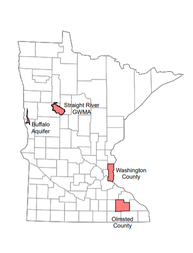 1) Fargo-Moorhead relies on a small buried glacial aquifer that isn’t easily recharged and doesn’t have a lot of capacity. It may limit development of the region. Moorhead also has an annual flooding problem and we will ask whether recharge can siphon off some of the flood waters. 2) The Straight River Groundwater Management area near Park Rapids. This sandy area is intensively irrigated cropland and seasonal lows in the water table aquifer have the potential to have a thermal impact on a coldwater stream. The city of Park Rapids has also had problems with nitrate in shallow groundwater. We’ll study whether water is available at the right time of year to offset drawdown and if it can dilute nitrate contamination and keep the stream cool. 3) Southern Washington County has a similar problem of aquifer depletion impacting a coldwater stream but in this case is a bedrock aquifer. Located in a growing metropolitan area, the current use may not be sustainable. The migration of 3M legacy contaminants (PFOS, PFOA) into parts of the aquifer used for a municipal supply well is a long-term problem in search of a solution. Recharging aquifers with clean water may provide relief for both of these future scenarios. 4) Greater Rochester is planning for a doubling of population due to expansion of the medical campus. Our question: Will their bedrock aquifer be adequate and remain free of contamination or will groundwater quantity and quality limit their ability to expand? The project is now ongoing, and will give a report to the 2021 Legislature. We will follow this work in the LWV UMRR blog and report peridically on prgress.
It is important to note that even if Managed Aquifer Recharge turns out to be a promising practice, there concerns and regulatory hurdles to be surmounted if it is to go into use in Minnesota. So the research here is just one step toward a major change in water management in Minnesota. Some resources for more information: University of Minnesota Water Resources Center: https://www.wrc.umn.edu/banking-groundwater-managed-aquifer-recharge Freshwater Society Facets of Freshwater: https://freshwater.org/2019/09/24/recharge/
0 Comments
Leave a Reply. |
| LWV Upper Mississippi River Region | UMRR blog |

 RSS Feed
RSS Feed